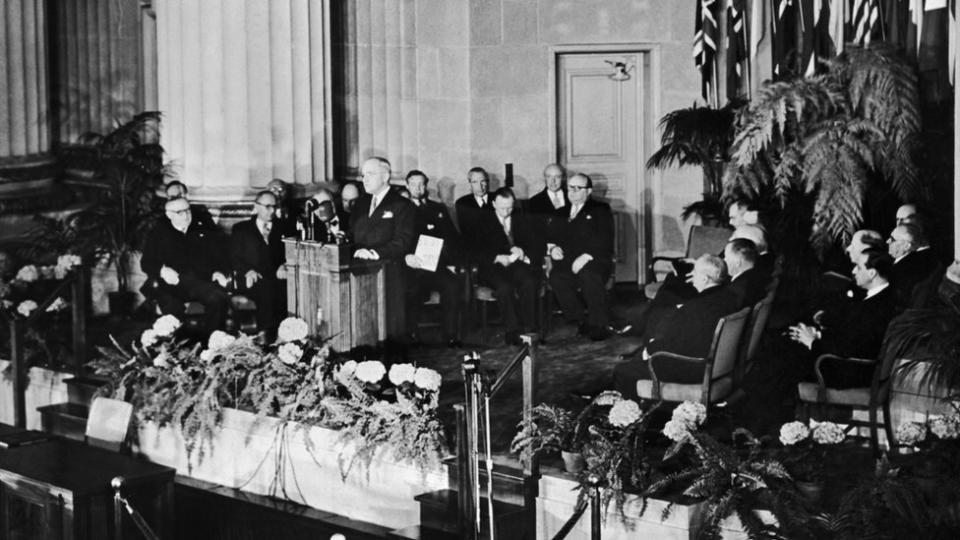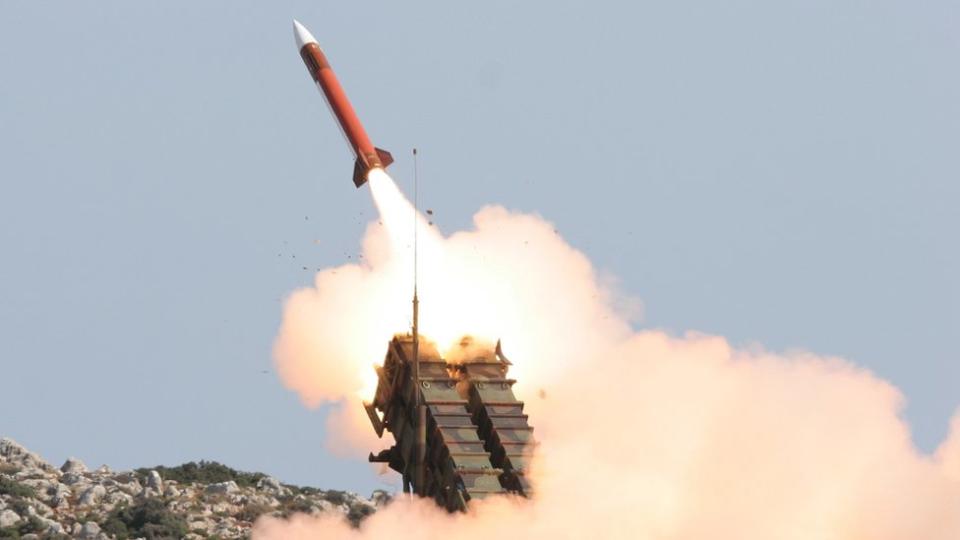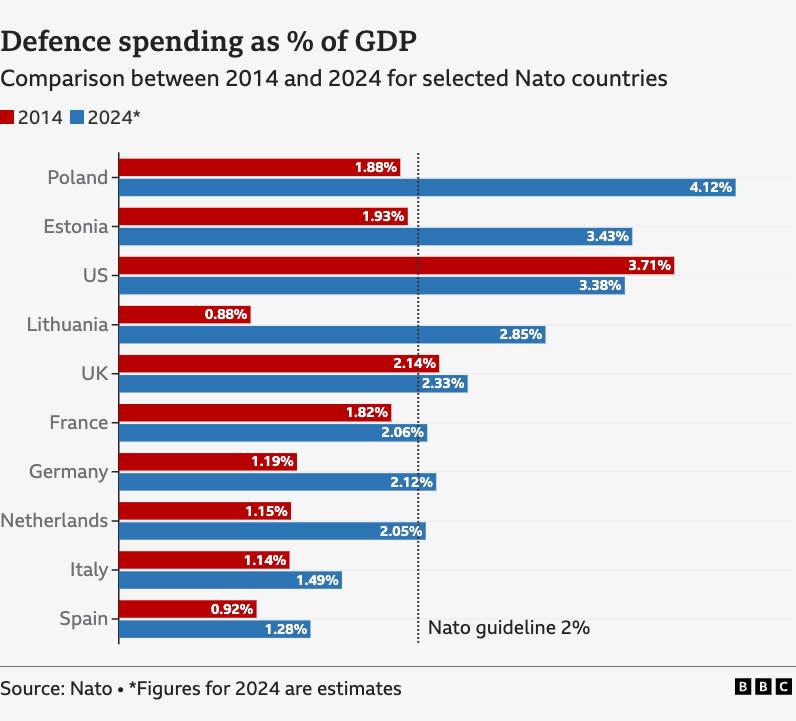What is Nato, which countries are members and when might Ukraine join?

Nato has said Ukraine is on an "irreversible path" towards future membership, and has promised more aid.
UK Prime Minister Sir Keir Starmer and US President Joe Biden were among world leaders pledging their support for Ukraine at the Nato summit in Washington DC.
In a speech to mark the 75th anniversary of the military alliance, Mr Biden said it was "more powerful than ever".
What is Nato and why was it set up?
Nato - the North Atlantic Treaty Organization - was formed in 1949 by 12 countries, including the US, UK, Canada and France.
Its founding treaty was signed in Washington DC, and leaders of Nato countries marked the anniversary on the first day of the Washington summit, 9 July.

Nato's primary purpose was to block expansion in Europe by the Soviet Union - a group of communist republics which included Russia.
Members agree that if one of them is attacked, the others should help defend it.
Nato does not have an army of its own, but member countries can take collective military action in response to crises.
The alliance supported the UN by intervening in the war in the former Yugoslavia between 1992 and 2004.
It also co-ordinates military plans and carries out joint military exercises.
Which countries are Nato members?
Nato has 32 members across Europe and North America, including the UK, US, Canada, France, Germany, Italy, Spain and Turkey.
After the Soviet Union's collapse in 1991, many Eastern European countries joined: Albania, Bulgaria, Hungary, Poland, the Czech Republic, Slovakia, Romania, Lithuania, Latvia and Estonia.

Finland - which has a 1,340km (832 mile) land border with Russia - joined in April 2023. Sweden became a member in March 2024.
Both had applied to join in May 2022, shortly after Russia invaded Ukraine, having been neutral for decades.
Ukraine, Bosnia and Herzegovina, and Georgia also hope to join Nato.
Why is Ukraine not in Nato, and when could it join?
Russia has consistently opposed the idea of Ukraine joining Nato, fearing it would bring the alliance's forces too close to its borders.
However, in 2008, Nato said that Ukraine could eventually join.
After Russia's invasion in 2022, Ukraine's President Volodymyr Zelensky asked for his country to be admitted as soon as possible.
Outgoing Nato secretary-general Mr Stoltenberg previously said it was "inevitable" that Ukraine would become a member, but not until its war with Russia ends.

Since July 2023, the US-led Ukraine Defense Contact Group has been co-ordinating efforts to give Ukraine weapons and training to defend itself against Russia.
Nato is proposing to take over that role by creating a $100bn (£77.3bn) fund to support Ukraine over the next five years.
Although the Washington summit did not agree a formal timeline for Ukraine to join the alliance, member countries restated their "unwavering" backing for the country.
"Support to Ukraine is not charity," Mr Stoltenberg said. "It is in our own security interest."
How are Nato countries helping Ukraine?
Nato said Russia's invasion of Ukraine posed the "most significant and direct threat to allies' security".
The body has not sent troops to Ukraine or enforced a no-fly zone over the country, for fear of being pulled into a direct conflict with Russia.
However, individual members have supplied arms to help Ukraine defend itself.
The German research organisation the Kiel Institute says the US has allocated 50.4bn euros (£42.6bn) for military support to Ukraine, while European countries - Denmark, Germany, the Netherlands, Poland and the UK - have allocated 32bn euros (£27bn).
The US, UK, Germany and Turkey and others have provided anti-tank weapons, missile defence systems, artillery guns, tanks and military drones. The US, UK and France have also supplied long-range missiles.

Speaking at the Washington summit, President Joe Biden said the US would partner with Germany, Italy, the Netherlands and Romania to donate Patriot missile batteries and other systems to bolster Ukraine's air defences.
This follows Russian air attacks across Ukraine on 8 July which destroyed a children's hospital in Kyiv and killed 43 people across the country, according to officials.
Mr Zelensky has spent months pleading with his Western allies for more weapons.
Earlier in 2024, supplies of US munitions dried up after a bill to give more military support to Ukraine was delayed for several months. European weapons makers were unable to fill the gap.
The US is letting two Nato countries, Denmark and the Netherlands, send US-made F-16 fighter jets to Ukraine. The first planes are expected to arrive later this summer.
How is Nato increasing its defences against Russia?
In 2023, Nato commanders agreed detailed plans for countering possible Russian attacks anywhere in the Arctic and north Atlantic, central Europe, or the Mediterranean region.
It has increased the number of troops in Europe on high alert from 40,000 to more than 300,000.
The alliance has also bolstered its defences on Russia's borders with eight battlegroups.
How much do Nato members spend on defence?
Nato asks every member country to spend at least 2% of its national income on defence, and 23 of them are projected to meet that target in 2024. Only three did in 2014.

The biggest spenders (in proportion to the size of their economies) are the US and countries close to Russia, such as Poland and the Baltic Republics.
Nato's European members and Canada collectively increased their defence spending by an estimated 9% in 2023, and are forecast to increase it by another 18% in 2024.

Former Conservative Prime Minister Rishi Sunak previously committed the UK to increasing its military budget to 2.5% of national income from the current 2.3%.
Speaking while travelling to the Washington summit, Sir Keir Starmer insisted the Labour government will honour that pledge.
However, the new armed forces minister, Luke Pollard, has not said when the target will be met.
When he was US President, Donald Trump pushed European Nato members to boost their defence spending.
During the current presidential election campaign, Mr Trump - who is the presumptive Republican nominee - warned that if he was re-elected, he might encourage Russia to attack Nato countries which failed to spend enough.
Mr Stoltenberg said his suggestion "undermines all of our security".
At a campaign rally ahead of the summit, Mr Trump told supporters that Nato countries were now contributing "hundreds of billions of dollars" more because he had warned them: "No, I will not protect you from Russia" unless they paid more to the alliance.


